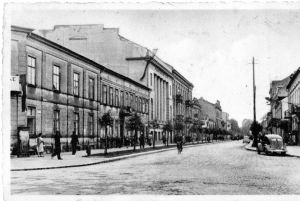Włocławek
Wloclawek is a town in Northern Poland, and during the German occupation it was re-named Leslau, and was administered as part of the Reichsgau Posen. In the early 1930’s, there were about 10,200 Jews living in Wloclawek, representing approximately 20 percent of the town’s population. They earned their living mainly from commerce and artisanship, while several owned factories. Wloclawek had a community council with twelve members; various Zionist parties and youth movements held ongoing activities. The Jewish community had welfare institutions and a hospital. Jewish schools included a high school, elementary schools, and Yeshivot and public libraries.
On 14 September 1939, the Germans occupied Wloclawek and immediately began to plunder Jewish-owned property and terrorise and abuse Jewish inhabitants. On 24 September 1939, SS men burned down synagogues as well as the prayer house of the Gerrer Hasidim. The Germans accused the Jews of setting the fires and took 800 Jews hostage, demanding a ransom of 100,000 zlotys from the Jewish community of Wloclawek for their release. Several days later, another 200,000 zlotys was demanded, and one week later, yet another 250,000 zlotys. The German administration in Wloclawek was headed by Hans Kramer together with his deputy, Max Dunkhorst, a Nazi agent who had worked as a teacher in the Jewish high school. On 25 September 1939, the Jews were ordered to wear a yellow badge and report for forced labour. Many of the town’s Jews left for Warsaw, Kutno and other locations, some of the younger Jews left for areas controlled by the Soviets. In late 1939, Wloclawek was annexed to the Third Reich, and the Germans changed its name to Leslau. On 1 December 1939, thousands of the town’s Jews were deported to Orzechow; on 15 December to Wloszczowa and Zamosc; and on 15 February 1940 to Tarnow. Following these transports, approximately 4,000 Jews remained in Wloclawek and in late 1940 a ghetto was established in a neglected area of the town and its Polish residents were evicted and replaced with Jews. On 9 November 1940, the ghetto was encircled by a barbed –wire fence and SS guards were placed in charge of guarding the ghetto. The Judenrat was given the task of maintaining internal order. Initially, non-Jews were permitted to enter the ghetto. Within a short time starvation in the ghetto rose, and a public soup kitchen was organised to relieve the suffering. On 26 June 1941, the Germans ordered the Jews to report for forced labour, mainly in the Poznan (Posen) District and on 26 September and 31 October 1941, some 920 Jews, mostly women, children and the elderly were deported from the town to the Lodz (Litzmannstadt) ghetto. An entry in the Chronicle of the Lodz Ghetto 1941 -1944 recalled their arrival:
On September 26 the first transport arrived, as announced, bearing new residents for the ghetto. More than 900 people, almost exclusively women and children, all of whom had been expelled from Wloclawek, arrived by rail at the Radogoszcz sidetrack (in Marysin). The Eldest of the Jews ordered that the newcomers be given the best possible care. They have been provisionally been quartered in houses at Marysin and in the prison building that had been vacated for the holiday furlough. On 6 November 1941, the ghetto was completely sealed off. The Jewish residents risked their lives in attempts to obtain food from their Polish neighbours. Those caught smuggling food were summarily shot. Expert tailors and shoemakers worked for German companies outside of the ghetto. The main cultural activities in the ghetto were concentrated in a building near the cemetery that had previously served to purify the dead prior to burial; the building also housed a public soup kitchen and functioned as a site for political meetings. In the spring of 1942, the Germans began to liquidate the ghetto. On 24 April 1942, about 400 men were sent to labour camps in Kobylepole and other places in the Poznan District, where many perished under the brutal conditions. The ghetto was finally liquidated on 27 April 1942, when women, children and the elderly were loaded onto trucks and transported to the Chelmno death camp, where they were murdered in the deadly gas-vans.
Sources:
The Yad Vashem Encylopiedia of the Ghettos During the Holocaust Volume 1, Yad Vashem, 2009.L. Dobroszycki (editor), The Chronicle of the Lodz Ghetto 1941-1944, Yale University Press New Haven and London, 1984
Photograph - Chris Webb Archive
© Holocaust Historical Society 2014


